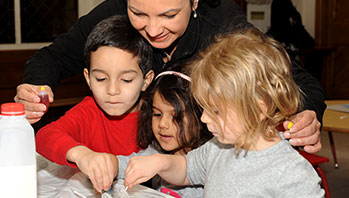- art supplies
- camera (optional)
- paper
- pictures and photographs of a variety of cats
- word cards same and different
- different
- same
MA Standards:
Speaking and Listening/SL.PK.MA.1: Participate in collaborative conversations with diverse partners during daily routines and play.
Writing/W.PK.MA.2: Use a combination of dictating and drawing to explain information about a topic.
MA Draft STE Standards
Physical Sciences/Matter and Its Interactions/Structure and Properties of Matter/PS1.A: Describe, compare, sort and classify objects based on observable physical characteristics, uses, and whether it is manufactured as part of their classroom play and investigations of the natural and human-made world.
Life Sciences/From Molecules to Organisms/LS1/3.A: Describe/draw and compare the body parts of animals (including themselves) and plants they are investigating [System] and explain functions of some of the observable body parts. [Structure and Function]
Head Start Outcomes:
Social Emotional Development/
Social Relationships: Cooperates with others.
Approaches to Learning/Cooperation: Plans, initiates, and completes learning activities with peers.
Logic & Reasoning/Problem Solving: Classifies, compares, and contrasts objects, events, and experiences.
Conceptual Knowledge of Natural & Physical Worlds: Observes, describes, and discusses living things and natural processes.
PreK Learning Guidelines:
English Language Arts 4: Engage in play experiences that involve naming and sorting common words into various classifications using general and specific language.
English Language Arts 16: Use their own words or illustrations to describe their experiences, tell imaginative stories, or communicate information about a topic of interest.
English Language Arts 20: Generate questions and gather information to answer their questions in various ways.
Science and Technology 1: Ask and seek out answers to questions about objects and events with the assistance of interested adults.
Science and Technology 4: Record observations and share ideas through simple forms of representation such as drawings.
Science and Technology 10: Observe and identify the characteristics and needs of living things: humans, animals, and plants.
Small Group: Same or Different

© Commonwealth of Massachusetts, Department of Early Education and Care (Jennifer Waddell photographer). All rights reserved.
Display the cat pictures and turn children’s attention to the list that shows how cats are the same and different.
Tell children they will work with a partner and that each child will make a cat that is the same as their partners's in some way or different from it in some way.
- Have each pair choose a “same” or “different” card. Instruct partners to create a cat that has one or two things that are the same or different from their partner’s cat (depending on what card they chose.)
- Before children begin, read the list and demonstrate drawing two cats that have the same color fur and the same color eyes. Be available to help children understand same and different as they work together.
Create a “Same” and “Different” board and have children hang their creations side by side in the correct area. Allow time for each pair to describe what is the same or different about their cats.
Educator Tip: You may want to take pictures of children working together with a friend so you can send them home at the end of the week.
